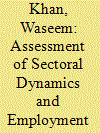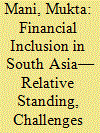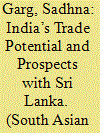| Srl | Item |
| 1 |
ID:
161097


|
|
|
|
|
| Summary/Abstract |
This study has analysed structural transformation and inter-sectoral relationships
of the Indian and the Chinese economy. Variation in employment dynamics
across the sectors and growth instability is also examined by taking data from
the World Development Indicators (WDI, 2015) of the World Bank. The study
has revealed that there is a gradual decline in agriculture in both the countries.
Both the economies are now concentrating at service sectors. China is fully
exploiting its industrial sector potential while India has been lagging behind in
this sector. Johansen’s cointegration approach revealed the existence of one
cointegration relationship among all the three sectors, namely, agricultural,
industrial and services, at 5 per cent level of significance for both the countries.
A passive employment shift has been seen from agriculture to non-agriculture
sector in India. Occupational transformation in China is faster than India. Policy
makers should focus on job generation, especially in services and labour intensive
manufacturing sector in India. China should try to create jobs in industrial and
services sector because agriculture sector has been sharply declining and is still
carrying huge load of employment.
|
|
|
|
|
|
|
|
|
|
|
|
|
|
|
|
| 2 |
ID:
161099


|
|
|
|
|
| Summary/Abstract |
Financial Inclusion is eminent for sustained growth in South Asia. This study is
an attempt to measure and comparatively analyze the levels of financial inclusion
in South Asian countries. On the basis of eighty-nine parameters, it is found that
the situation of financial inclusion in South Asia is modest as compared to other
regions of the world. The usage of banking services, use of debit and credit cards,
bank-borrowing, deposit of savings is at low levels. The use of e-banking is also
extremely low; however, the mobile-banking is picking up. The gender bias is high
in most of the countries as there are more male users as compared to female
users. Many initiatives are being taken to promote financial inclusion and the
situation has also improved data-wise, but there is still is a long way to go. This study
is distinguished in providing a comparative picture of South Asian countries.
|
|
|
|
|
|
|
|
|
|
|
|
|
|
|
|
| 3 |
ID:
161096


|
|
|
|
|
| Summary/Abstract |
Under the wave of regionalism, India like other developing countries started
to integrate at regional level. At the initial stage, it wanted to establish strong
trade relations with its neighbouring countries. It (India) signed its first free
trade agreement (FTA) with Sri Lanka in 1998, which became operational from
2000. Thereafter, bilateral trade continued to increase with increasing rate. It
is in this context, the present study attempts to explore India’s trade potential
and prospects with Sri Lanka, utilised revealed comparative advantage (RCA) and
trade intensity Index (TII). The results of RCA show that India has strong and
sustainable trade specialisation (RCA > 1) in the export of edible vegetables
and certain roots and tubers, coffee, tea mate and spices, cotton etc to Sri Lanka.
This comparative advantage helps not only to diversify product baskets, but also
lead to increased volume of trade. India has no comparative advantage in the
import of any product from Sri Lanka. India has intensity of trade with Sri Lanka
since 1991. India has sustainable trade potential and prospects with Sri Lanka and
been a net exporter to it. Efforts should be made to utilise this potential.
|
|
|
|
|
|
|
|
|
|
|
|
|
|
|
|
| 4 |
ID:
161098


|
|
|
|
|
| Summary/Abstract |
This article discusses welfare measures in the formal sector being constrained by
labour legislation which is, at best, empirically fragile. This very fragility requires
us to view labour laws and possible reforms using conceptual frames that are not
preoccupied with de jure legislation but rather focus on the actual implementation
of the law considering judicial and executive practice. Various factors taken
together complemented by empirical work in Gujarat reflect that while labour
laws are supposed to be operational in a special economic zones (SEZ), they are
almost absent in practice. This study is based on both theoretical and empirical
methods. This study suggests systematic non-implementation of labour welfare
measures that have a negative implication on workers in each and every way
possible. This has led the workers in SEZs to earn their living in an atmosphere
of threat, fear and uncertainty.
|
|
|
|
|
|
|
|
|
|
|
|
|
|
|
|